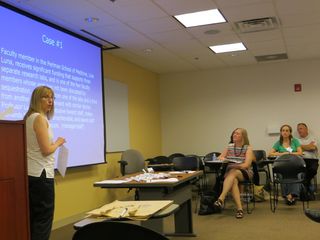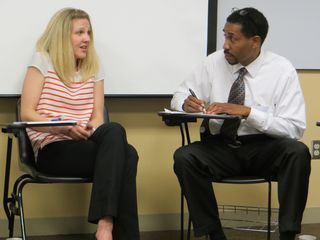Penn Doctors Spend aDay in Their Patient’s Shoes
If a doctor applies aband-aid with a smile, does a wound heal faster? Maybe not, but in today’schanging health care landscape, health systems, physicians and insuranceproviders alike are placing more emphasis on patient satisfaction, and recentresearch suggests that it might not be safe to assume that a healthy patient isa happy patient. According to an article in arecent issue of AAOS Now, the journal of the American Academy of OrthopedicSurgeons, historically, physicians have focused on technique and objectiveoutcomes as measures of ‘patient satisfaction,’ while patients have viewed theirsatisfaction as a reflection of the physician-patient relationship.

Autumn Fiester, PhD, director of the Center for Clinical Ethics Mediation, leads a course for Penn faculty and staff on conflict-resolution
Now, in an effort to continue raising the bar on our qualityof care and help faculty to refine their leadership and development skills,Penn Medicine’s Center for Clinical Ethics Mediation is providing courses aimedat arming clinicians with the skills necessary to facilitate conflictresolution at the bedside. In the health care setting, “conflict” can arisewhen there are miscommunications over a patient’s medication regimen, differingopinions regarding a course of treatment, cultural differences, etc. Thecourses offered through the Center for Clinical Ethics Mediation take facultyand staff out of the exam room and into the classroom where, through a seriesof role-playing exercises, they are able to experience firsthand what it’s likewalking in their patients’ shoes.

Courses place faculty and staff from all UPenn entities in role-playing exercises designed to bolster mediation skills
Traditional mediation techniques involve an outside thirdmember bringing together the conflicting parties to reach a resolution. As analternative to these strategies which can sometimes leave people feeling asthough a pre-packaged solution has been imposed upon them, the Center forClinical Ethics Mediation uses role-playing exercises to place clinicians inreal-life scenarios where a health care provider and his or her patient (or thepatient’s family, as the case may be), may not see eye-to-eye. The exercises,which can be quite emotional, are designed to help providers to betterunderstand a patient’s perspective and facilitate a conversation andresolution.
“The biggest lesson was to notice the other person’sposition and to force myself to see the other side,” said Victoria Mulhern,executive director of Faculty Affairs & Professional Development, who hasattended several multi-day workshops on mediation techniques. “Under certaincircumstances, doctors and nurses can impose care, but the discussion processthat leads to a resolution everyone is comfortable with provides support andmakes bad situations less hurtful. We want our patients to know that we’re on theirside, and the only way to do that is to make sure they are an equal part of theconversation.”
In one exercise, physicians are asked to take on the role ofan elderly patient whose growing compendium of ailments is making everydaytasks almost impossible. While a physician may immediately see that the bestoption would be for the patient to enter an assisted living facility, a patientwho has always lived a very independent life may not agree. The goal of theexercise is not to make the patient understand “doctor’s orders,” but rather tounderstand the patient’s perspective and find a resolution that is satisfyingfor both parties. Other role-playing scenarios, such as when a patient’s familyis divided over a course of treatment or when end-of-life decisions arenecessary, can be even more emotionally taxing.
“The only way you learn to resolve conflicts, is byresolving conflicts,” says Autumn Fiester, PhD, director of the Center for ClinicalEthics Mediation. “Health care situations can be very stressful and emotionalfor patients and their families, and sometimes, communication breakdowns canlead to conflict for even the best health care providers. Our goal with these workshopsis to provide a better overall patient experience by helping the clinicians tofacilitate resolutions that work for everyone involved.”
Fiester says that faculty and staff who complete programsacquire valuable skills that prepare them to manage conflicts caused bycommunication breakdowns, cultural differences, and disparate value systems. Byencouraging open expression of each individual’s feelings, thoughts, values,and perspectives, mediation works to promote shared resolutions to the fullspectrum of conflicts between and among healthcare providers, patients, andfamily members.
Outside of the exam room, Mulhern hopes the skills acquiredin the classes will help physicians become better leaders.
“We want our seasoned veterans to lead by example,” shesaid. “We have so many talented young people coming to Penn Medicine, and we wantour leaders to be mentors to them not just in the operating room, but at thebedside and within their own departments. By providing these skills to facultyat all levels, we hope to create improved satisfaction across the board.”